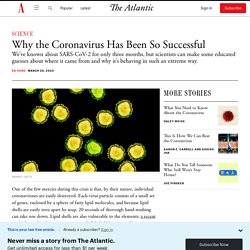

New Immune Cell on the Block During Viral Lung Infections. Scientists have identified a novel group of immune cells in the lungs that are associated with the control of inflammation during viral infections, like influenza or possibly coronavirus.

This discovery may help to advance the development of therapeutics to treat inflammation-related lung conditions such as bronchitis, influenza and potentially even COVID-19. Macrophages are an important subset of phagocytic immune cells found throughout the body that form part of our body’s first line of defense against invading foreign material, including bacteria and viruses.
Alveolar macrophages (AMs) are a well-known inhabitant of the lungs and are responsible for direct clearance of viruses. This new group of immune cells, identified in the lungs of mice, are a distinct group of macrophages, dubbed NAMs (nerve and airway associated macrophages), that appear instead to moderate inflammation in the lungs during viral infection. The study was published today in Science Immunology. What We Know So Far About SARS-CoV-2. This uncanny fit will doubtlessly encourage conspiracy theorists: What are the odds that a random bat virus had exactly the right combination of traits to effectively infect human cells from the get-go, and then jump into an unsuspecting person?

“Very low,” Andersen says, “but there are millions or billions of these viruses out there. These viruses are so prevalent that things that are really unlikely to happen sometimes do.” Since the start of the pandemic, the virus hasn’t changed in any obviously important ways. It’s mutating in the way that all viruses do. But of the 100-plus mutations that have been documented, none has risen to dominance, which suggests that none is especially important. Read: The U.K.’s coronavirus “herd immunity” debacle There’s one possible exception.
Spike mutation pipeline reveals the emergence of a more transmissible form of SARS-CoV-2. The coronavirus did not escape from a lab. Here's how we know. Editor's note: On April 16, news came out that the U.S. government said it was investigating the possibility that the novel coronavirus may have somehow escaped from a lab, though experts still think the possibility that it was engineered is unlikely.

This Live Science report explores the origin of SARS-CoV-2. As the novel coronavirus causing COVID-19 spreads across the globe, with cases surpassing 284,000 worldwide today (March 20), misinformation is spreading almost as fast. One persistent myth is that this virus, called SARS-CoV-2, was made by scientists and escaped from a lab in Wuhan, China, where the outbreak began. A new analysis of SARS-CoV-2 may finally put that latter idea to bed. "Our analyses clearly show that SARS-CoV-2 is not a laboratory construct or a purposefully manipulated virus," they write in the journal article. Related: 13 coronavirus myths busted by science Another nail in the "escaped from evil lab" theory? Where did the virus come from?
SARS-CoV-2 Vaccine. MEDIALIST. SARS CoV 2 Alive or Dead? Nextstrain / narratives / ncov / sit-rep / 2020-01-30. SAR-COV-2 Academic. About those spikes... Nextstrain / ncov / north-america. Possible Central Nervous System Infection by SARS Coronavirus. Severe Acute Respiratory Syndrome (SARS) Ho MSI think I got “That Disease”: an interview with a medical student who had recovered from SARS in Guangzhou, China Public Health, 120 (2006), p. 6 Drosten C, Gunther S, Preiser W, et al.Identification of a novel coronavirus in patients with severe acute respiratory syndrome N Engl J Med, 348 (2003), p. 1967 Ksiazek TG, Erdman D, Goldsmith CS, et al.A novel coronavirus associated with severe acute respiratory syndrome N Engl J Med, 348 (2003), p. 1953 Guan Y, Zheng BJ, He YQ, et al.Isolation and characterization of viruses related to the SARS coronavirus from animals in southern China Science, 302 (2003), p. 276 Lau SK, Woo PC, Li KS, et al.Severe acute respiratory syndrome coronavirus-like virus in Chinese horseshoe bats Proc Natl Acad Sci USA, 102 (2005), p. 14040 Li W, Shi Z, Yu M, et al.Bats are natural reservoirs of SARS-like coronaviruses Science, 310 (2005), p. 676 J Virol, 79 (2005), p. 11892 Proc Natl Acad Sci USA, 102 (2005), p. 2430 Emerg Infect Dis, 11 (2005), p. 1860 WHO.

COVID-19. COVID-19 Treatments. COVID-19 Clues. TESTING US. Epidēmia. Monster Models. Virology. Zoonology. PANDEMOCRACY.